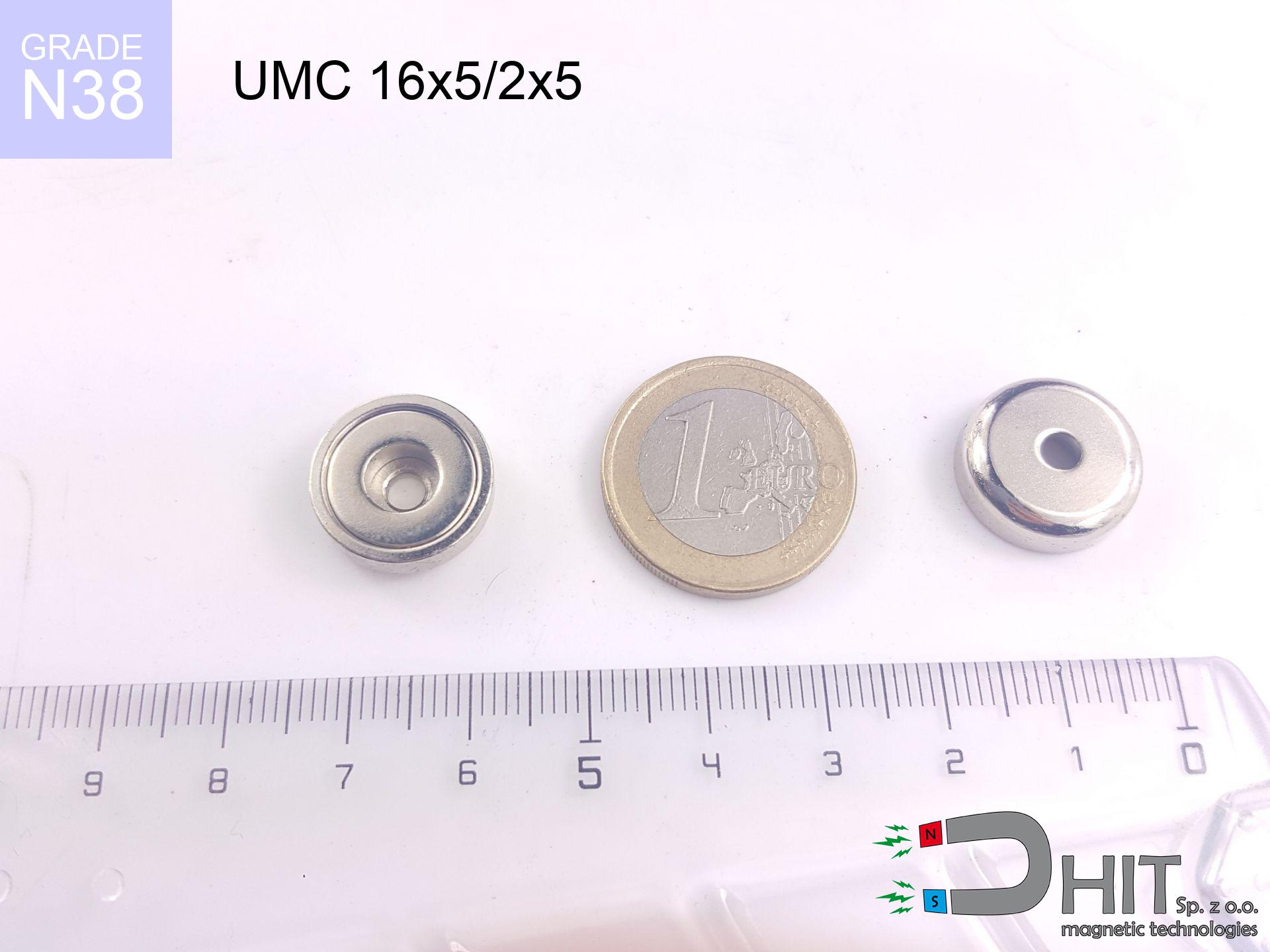UMC 16x5/2x5 / N38 - cylindrical magnetic holder
cylindrical magnetic holder
Catalog no 320406
GTIN: 5906301814627
Diameter [±0,1 mm]
16 mm
internal diameter Ø [±0,1 mm]
5/2 mm
Height [±0,1 mm]
5 mm
Weight
5.5 g
Load capacity
4 kg / 39.23 N
Coating
[NiCuNi] nickel
3.33 ZŁ with VAT / pcs + price for transport
2.71 ZŁ net + 23% VAT / pcs
bulk discounts:
Need more?Not sure about your choice?
Give us a call
+48 888 99 98 98
or contact us using
form
our website.
Force and structure of magnets can be estimated using our
modular calculator.
Same-day shipping for orders placed before 14:00.
UMC 16x5/2x5 / N38 - cylindrical magnetic holder
Magnetic properties of material N38
Physical properties of NdFeB
Shopping tips
Advantages and disadvantages of neodymium magnets NdFeB.
In addition to their immense strength, neodymium magnets offer the following advantages:
- They have constant strength, and over nearly ten years their attraction force decreases symbolically – ~1% (in testing),
- They are very resistant to demagnetization caused by external magnetic sources,
- By applying a reflective layer of silver, the element gains a clean look,
- The outer field strength of the magnet shows remarkable magnetic properties,
- With the right combination of compounds, they reach excellent thermal stability, enabling operation at or above 230°C (depending on the form),
- With the option for tailored forming and precise design, these magnets can be produced in multiple shapes and sizes, greatly improving engineering flexibility,
- Key role in advanced technical fields – they find application in hard drives, electromechanical systems, medical equipment as well as technologically developed systems,
- Relatively small size with high magnetic force – neodymium magnets offer impressive pulling strength in small dimensions, which makes them ideal in miniature devices
Disadvantages of neodymium magnets:
- They are fragile when subjected to a sudden impact. If the magnets are exposed to external force, they should be placed in a steel housing. The steel housing, in the form of a holder, protects the magnet from cracks , and at the same time strengthens its overall resistance,
- High temperatures may significantly reduce the strength of neodymium magnets. Typically, above 80°C, they experience permanent weakening in performance (depending on height). To prevent this, we offer heat-resistant magnets marked [AH], capable of working up to 230°C, which makes them perfect for high-temperature use,
- They rust in a damp environment. If exposed to rain, we recommend using waterproof magnets, such as those made of plastic,
- Using a cover – such as a magnetic holder – is advised due to the difficulty in manufacturing fine shapes directly in the magnet,
- Potential hazard due to small fragments may arise, when consumed by mistake, which is notable in the family environments. It should also be noted that small elements from these magnets might hinder health screening once in the system,
- In cases of mass production, neodymium magnet cost is a challenge,
Magnetic strength at its maximum – what affects it?
The given lifting capacity of the magnet means the maximum lifting force, measured in a perfect environment, specifically:
- with the use of low-carbon steel plate acting as a magnetic yoke
- of a thickness of at least 10 mm
- with a polished side
- with zero air gap
- under perpendicular detachment force
- under standard ambient temperature
What influences lifting capacity in practice
The lifting capacity of a magnet is influenced by in practice the following factors, from primary to secondary:
- Air gap between the magnet and the plate, because even a very small distance (e.g. 0.5 mm) can cause a drop in lifting force of up to 50%.
- Direction of applied force, because the maximum lifting capacity is achieved under perpendicular application. The force required to slide the magnet along the plate is usually several times lower.
- Thickness of the plate, as a plate that is too thin causes part of the magnetic flux not to be used and to remain wasted in the air.
- Material of the plate, because higher carbon content lowers holding force, while higher iron content increases it. The best choice is steel with high magnetic permeability and high saturation induction.
- Surface of the plate, because the more smooth and polished it is, the better the contact and consequently the greater the magnetic saturation.
- Operating temperature, since all permanent magnets have a negative temperature coefficient. This means that at high temperatures they are weaker, while at sub-zero temperatures they become slightly stronger.
* Holding force was tested on the plate surface of 20 mm thickness, when the force acted perpendicularly, whereas under attempts to slide the magnet the load capacity is reduced by as much as 75%. In addition, even a small distance {between} the magnet and the plate decreases the lifting capacity.
We Recommend Caution with Neodymium Magnets
Neodymium magnets are the strongest magnets ever created, and their power can shock you.
Read the information on our website on how to properly utilize neodymium magnets and avoid significant harm to your body and unintentional damage to the magnets.
Dust and powder from neodymium magnets are flammable.
Avoid drilling or mechanical processing of neodymium magnets. Once crushed into fine powder or dust, this material becomes highly flammable.
Neodymium magnets can become demagnetized at high temperatures.
In certain circumstances, Neodymium magnets can lose their magnetism when subjected to high temperatures.
Keep neodymium magnets away from people with pacemakers.
Neodymium magnets produce strong magnetic fields that can interfere with the operation of a heart pacemaker. Even if the magnetic field does not affect the device, it can damage its components or deactivate the entire device.
Keep neodymium magnets away from the wallet, computer, and TV.
Strong magnetic fields emitted by neodymium magnets can destroy magnetic storage media such as floppy disks, credit cards, magnetic ID cards, cassette tapes, video tapes, or other devices. In addition, they can damage televisions, VCRs, computer monitors, and CRT displays. You should especially avoid placing neodymium magnets near electronic devices.
Keep neodymium magnets as far away as possible from GPS and smartphones.
Intense magnetic fields generated by neodymium magnets interfere with compasses and magnetometers used in navigation, as well as internal compasses of smartphones and GPS devices.
If you have a nickel allergy, avoid contact with neodymium magnets.
Studies show a small percentage of people have allergies to certain metals, including nickel. An allergic reaction often manifests as skin redness and rash. If you have a nickel allergy, you can try wearing gloves or simply avoid direct contact with nickel-plated neodymium magnets.
Neodymium magnets can attract to each other, pinch the skin, and cause significant swellings.
Magnets will attract each other within a distance of several to around 10 cm from each other. Don't put your fingers in the path of magnet attraction, as a serious injury may occur. Magnets, depending on their size, are able even cut off a finger or there can be a serious pressure or a fracture.
It is important to maintain neodymium magnets away from youngest children.
Neodymium magnets are not toys. You cannot allow them to become toys for children. In the case of small magnets, they can be swallowed and cause choking. In such cases, the only solution is to undergo surgery to remove the magnets, and otherwise, it can even lead to death.
Neodymium magnets are delicate and can easily crack and get damaged.
Magnets made of neodymium are extremely delicate, and by joining them in an uncontrolled manner, they will crumble. Neodymium magnets are made of metal and coated with a shiny nickel surface, but they are not as hard as steel. In the event of a collision between two magnets, there may be a scattering of fragments in different directions. Protecting your eyes is crucial in such a situation.
Caution!
Please read the article - What danger lies in neodymium magnets? You will learn how to handle them properly.





![UMH 36x8x46 [M6] / N38 - magnetic holder with hook UMH 36x8x46 [M6] / N38 - magnetic holder with hook](https://cdn3.dhit.pl/graphics/products/umh-36x8x46-m6-wim.jpg)



